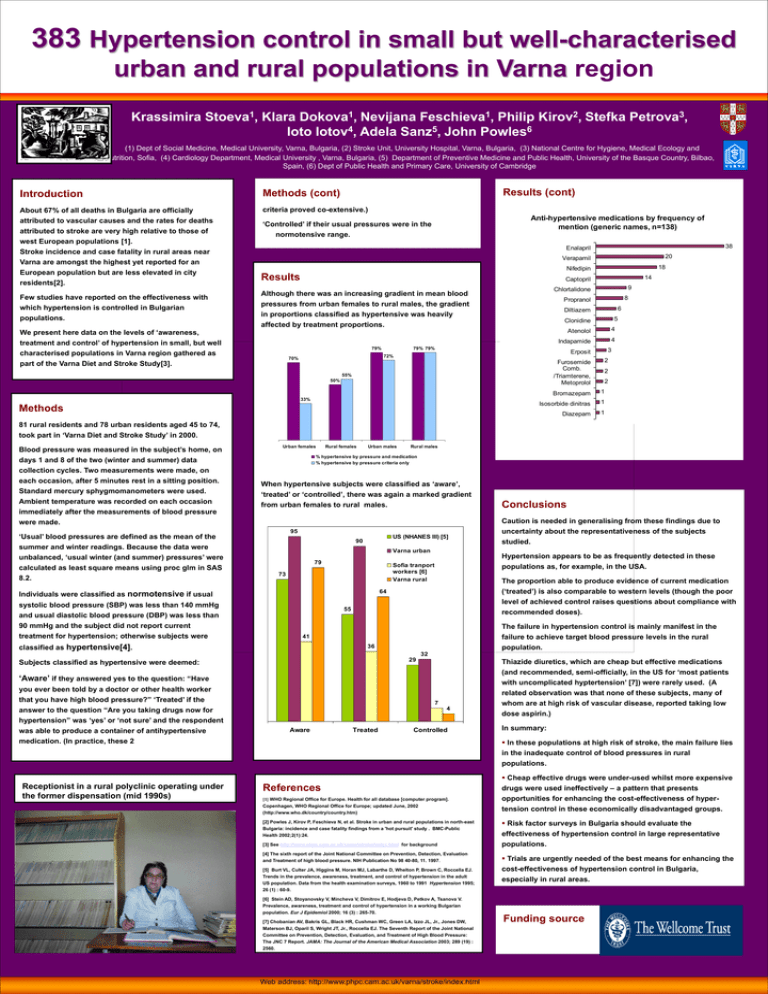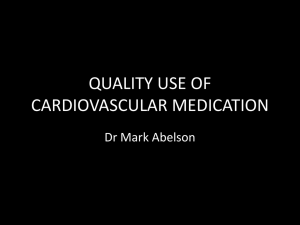(though the poor level of achieved control raises questions about
advertisement

383 Hypertension control in small but well-characterised urban and rural populations in Varna region Krassimira 1 Stoeva , 1 Dokova , 1 Feschieva , Klara Nevijana Philip 4 5 6 Ioto Iotov , Adela Sanz , John Powles 2 Kirov , 3 Petrova , Stefka (1) Dept of Social Medicine, Medical University, Varna, Bulgaria, (2) Stroke Unit, University Hospital, Varna, Bulgaria, (3) National Centre for Hygiene, Medical Ecology and Nutrition, Sofia, (4) Cardiology Department, Medical University , Varna, Bulgaria, (5) Department of Preventive Medicine and Public Health, University of the Basque Country, Bilbao, Spain, (6) Dept of Public Health and Primary Care, University of Cambridge Results (cont) Introduction Methods (cont) About 67% of all deaths in Bulgaria are officially criteria proved co-extensive.) attributed to vascular causes and the rates for deaths attributed to stroke are very high relative to those of Anti-hypertensive medications by frequency of mention (generic names, n=138) ‘Controlled’ if their usual pressures were in the normotensive range. west European populations [1]. Stroke incidence and case fatality in rural areas near residents[2]. Few studies have reported on the effectiveness with which hypertension is controlled in Bulgarian populations. 20 Verapamil Varna are amongst the highest yet reported for an European population but are less elevated in city 38 Enalapril 18 Nifedipin Results 8 Propranol pressures from urban females to rural males, the gradient 6 Diltiazem in proportions classified as hypertensive was heavily 5 Clonidine affected by treatment proportions. Atenolol 4 Indapamide 4 We present here data on the levels of ‘awareness, treatment and control’ of hypertension in small, but well 79% 79% 79% 3 Erposit 72% 70% 9 Chlortalidone Although there was an increasing gradient in mean blood characterised populations in Varna region gathered as 14 Captopril Furosemide Comb. /Triamterene, Metoprolol part of the Varna Diet and Stroke Study[3]. 55% 50% 33% Methods 2 2 2 Bromazepam 1 Isosorbide dinitras 1 Diazepam 1 81 rural residents and 78 urban residents aged 45 to 74, took part in ‘Varna Diet and Stroke Study’ in 2000. Blood pressure was measured in the subject’s home, on Urban females Rural females Urban males Rural males % hypertensive by pressure and medication % hypertensive by pressure criteria only days 1 and 8 of the two (winter and summer) data collection cycles. Two measurements were made, on each occasion, after 5 minutes rest in a sitting position. When hypertensive subjects were classified as ‘aware’, Standard mercury sphygmomanometers were used. ‘treated’ or ‘controlled’, there was again a marked gradient Ambient temperature was recorded on each occasion from urban females to rural males. Conclusions immediately after the measurements of blood pressure Caution is needed in generalising from these findings due to were made. 95 ‘Usual’ blood pressures are defined as the mean of the US (NHANES III) [5] 90 summer and winter readings. Because the data were Varna urban unbalanced, ‘usual winter (and summer) pressures’ were 79 calculated as least square means using proc glm in SAS 8.2. populations as, for example, in the USA. The proportion able to produce evidence of current medication (‘treated’) is also comparable to western levels (though the poor 64 Individuals were classified as normotensive if usual studied. Hypertension appears to be as frequently detected in these Sofia tranport workers [6] Varna rural 73 uncertainty about the representativeness of the subjects level of achieved control raises questions about compliance with systolic blood pressure (SBP) was less than 140 mmHg 55 and usual diastolic blood pressure (DBP) was less than recommended doses). 90 mmHg and the subject did not report current The failure in hypertension control is mainly manifest in the treatment for hypertension; otherwise subjects were failure to achieve target blood pressure levels in the rural 41 classified as hypertensive[4]. 36 population. 32 29 Subjects classified as hypertensive were deemed: Thiazide diuretics, which are cheap but effective medications (and recommended, semi-officially, in the US for ‘most patients ‘Aware’ if they answered yes to the question: “Have with uncomplicated hyptertension’ [7]) were rarely used. (A you ever been told by a doctor or other health worker related observation was that none of these subjects, many of that you have high blood pressure?” ‘Treated’ if the 7 answer to the question “Are you taking drugs now for 4 hypertension” was ‘yes’ or ‘not sure’ and the respondent was able to produce a container of antihypertensive Aware Treated Controlled medication. (In practice, these 2 whom are at high risk of vascular disease, reported taking low dose aspirin.) In summary: In these populations at high risk of stroke, the main failure lies in the inadequate control of blood pressures in rural populations. Cheap effective drugs were under-used whilst more expensive Receptionist in a rural polyclinic operating under the former dispensation (mid 1990s) References drugs were used ineffectively – a pattern that presents [1] WHO Regional Office for Europe. Health for all database [computer program]. Copenhagen, WHO Regional Office for Europe; updated June, 2002 (http://www.who.dk/country/country.htm) opportunities for enhancing the cost-effectiveness of hyper- [2] Powles J, Kirov P, Feschieva N, et al. Stroke in urban and rural populations in north-east Bulgaria: incidence and case fatality findings from a 'hot pursuit' study . BMC-Public Health 2002;2(1):24. Risk factor surveys in Bulgaria should evaluate the [3] See http://www.phpc.cam.ac.uk/varna/stroke/index.html for background populations. [4] The sixth report of the Joint National Committee on Prevention, Detection, Evaluation and Treatment of high blood pressure. NIH Publication No 98 40-80, 11. 1997. Trials are urgently needed of the best means for enhancing the [5] Burt VL, Culter JA, Higgins M, Horan MJ, Labarthe D, Whelton P, Brown C, Roccella EJ. Trends in the prevalence, awareness, treatment, and control of hypertension in the adult US population. Data from the health examination surveys, 1960 to 1991 Hypertension 1995; 26 (1) : 60-9. [6] Stein AD, Stoyanovsky V, Mincheva V, Dimitrov E, Hodjeva D, Petkov A, Tsanova V. Prevalence, awareness, treatment and control of hypertension in a working Bulgarian population. Eur J Epidemiol 2000; 16 (3) : 265-70. [7] Chobanian AV, Bakris GL, Black HR, Cushman WC, Green LA, Izzo JL, Jr., Jones DW, Materson BJ, Oparil S, Wright JT, Jr., Roccella EJ. The Seventh Report of the Joint National Committee on Prevention, Detection, Evaluation, and Treatment of High Blood Pressure: The JNC 7 Report. JAMA: The Journal of the American Medical Association 2003; 289 (19) : 2560. Web address: http://www.phpc.cam.ac.uk/varna/stroke/index.html tension control in these economically disadvantaged groups. effectiveness of hypertension control in large representative cost-effectiveness of hypertension control in Bulgaria, especially in rural areas. Funding source





